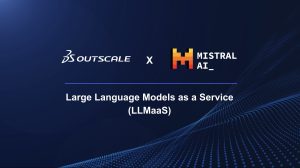Artificial intelligence (AI) is at the forefront of discussions today. This topic affects all companies and industries. While concepts like machine learning and deep learning have been around for over 15 years, the recent emergence of large language models (LLMs) has brought AI into the spotlight. In this article, we will explore the many opportunities for AI integration and the strategies to fully leverage them.
THE CHALLENGES OF GENERATIVE AI
1. Internal skills
The field of artificial intelligence, particularly regarding LLMs, is still relatively new, and many companies currently lack the necessary skills. Indeed, one of the main challenges when implementing such projects lies in the ability to mobilize internal expertise capable of determining the necessary actions, adopting the right methods, establishing the appropriate organization, planning accordingly, and, most importantly, ensuring effective integration within the company.
2. Infrastructure needs
The infrastructure requirements for LLMs are particularly high. Recent models require GPUs that consume hundreds of watts, making their integration into existing information systems challenging.
3. Supply chain delays
The growing demand for AI-compatible infrastructure has led to complications in the supply chain, resulting in delays of up to a year for certain components.
4. Integration into Cloud strategy
Integrating AI into a company’s existing cloud architecture poses a significant challenge, but it can also facilitate the adoption of new technologies by allowing AI integration via the cloud, rather than relying solely on on-premise deployments.
INTEGRATING GENERATIVE AI: FOUR ESSENTIAL DIMENSIONS FOR SUCCESS
The cloud offers agility and speed. Generative AI projects often evolve through iterative cycles: an initial experimentation phase, followed by testing, and then large-scale deployment, with increasing user numbers at each stage. This lifecycle closely resembles that of previous generations of AI.
To successfully implement a generative AI project, it is crucial to consider four essential dimensions:
1. The Business Case dimension – its importance, specifics, and value measurement protocol
Generative AI technology generates significant interest. What are the real opportunities it offers in a business context? The market is currently focusing its efforts on relatively common use cases, such as question-answering systems that can operate in a secure environment, as well as all Retrieval-Augmented Generation (RAG) solutions. Applications in content generation, such as product sheets and job descriptions, are also prevalent.
Furthermore, other use cases are gaining importance in the market, particularly around agents and their ability to partially or fully automate various processes. The starting point for this remains the business case, along with the involvement of a business sponsor to define a value measurement protocol. At each step of agile iterations, it is essential to have specific metrics that characterize performance. These metrics should primarily focus on business outcomes.
2. The importance of UX
This is the first time we see artificial intelligence models whose performance depends both on the prompt and on how users formulate it and interpret the responses provided by the model. This requires user training during the deployment of a use case to ensure they use the model correctly and do not take hallucinations at face value. Additionally, it is crucial to think about the UX surrounding the model, making it accessible through tools such as prompt libraries and guidelines that facilitate semi-automated pre-prompt configuration. Designing UX in this way optimizes model performance in the user context and ensures seamless integration into their processes and experience.
3. The importance of data foundations
From the outset of the use case lifecycle, it is essential to identify a set of documented and unstructured data, including procedures and metadata indicating their date and the document corpus they belong to.
4. Risk management and cybersecurity
There is an operational risk: what happens if the model starts to hallucinate? In a B2C context, this can have serious consequences in terms of impact. In terms of cybersecurity, does the model create new vulnerabilities in the information system? Are there potential flaws introduced by the model’s usage? To what extent is the model resistant to jailbreak attacks? Furthermore, from a legal and ethical standpoint, a regulatory framework, notably the AI Act, is developing to govern certain high-risk use cases and guide the choice of models, ensuring compliance with the requirements related to general AI providers.
There are several dimensions to incorporate into an end-to-end agile delivery cycle at all project stages to transition from rapid experimentation to effective large-scale deployment, balancing metrics with the trade-off between business value and costs.
MISTRAL AI x OUTSCALE: A PACKAGED OFFERING

At OUTSCALE, we have decided to focus on how we will support our ecosystem, as we have done for over ten years, to bring value to our clients. We therefore offer a managed service that enables our clients to deploy a complete inference stack. OUTSCALE manages the infrastructure as well as the qualification of all technical components: operating system, driver deployment, library management, inference server, and API server. All these elements are packaged and validated by us. Our partnership with Mistral AI allows us to guarantee the performance and security of the solutions while minimizing the risks of data mixing. Thanks to the Mistral AI x OUTSCALE partnership, you will benefit from an inference server with a model and infrastructure dedicated to you, ensuring that there is no confusion between the data.
Integrating generative AI requires a holistic approach that goes beyond mere technological choices. Internal skills, infrastructure, data, and cybersecurity are all key elements to consider. By leveraging managed solutions like those offered by OUTSCALE and Mistral AI, companies can simplify their deployment and focus on creating value.
To learn more about how OUTSCALE can help you integrate generative AI into your organization, discover Codestral, which supports your developers in all their programming tasks, from generating code in multiple languages to automating debugging. Also, check out Mistral Small, which caters to your low-latency conversational use cases, including those requiring RAG.

